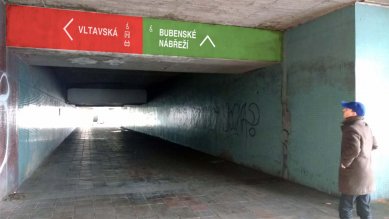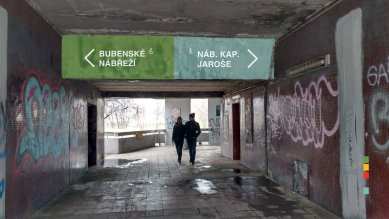
The revitalization of the underpasses at Vltavská is approaching
Prague, August 7, 2017 - What comes to your mind when you hear "underpasses at Vltavská"? Homeless people, neglect, confusion, the respondents agree. The space of the underpasses caught the interest of young architects and designers concerned about public space – a group called Architects Without Borders. They created a proposal in their free time to revitalize the area: a wayfinding system that will help everyone who gets lost find their way. It should be completed by mid-September.
The Hlávkův Bridge, which connects Florenc with Holešovice at the Vltavská metro station, was built in the early twentieth century. However, when significant advocacy for automobile traffic arose and the construction of the north-south highway began to be planned, the bridge was no longer sufficient in capacity, leading to its expansion. Massive "glasses" lacking human scale were created – ramps and access roads. The movement of pedestrians was to be solved by multi-level underpasses. The system has a total of 12 entrances, some via ramps, others by stairs. The uninviting dark environment, lost gradient, and overall confusion have taken their toll on the underpasses: even the ubiquitous graffiti testifies to the neglect of the area mentioned by passersby: "If you clean here, it's back to the same the next day." The underpasses have thus become an autonomous world inhabited by homeless people, cyclists pass through them, and pedestrians get lost there. There are plenty of nooks around the ramps, stairs, and other architectural elements where people sleep – whether in one of the oldest homeless colonies in Prague or just on a few cardboard boxes.
Architects Without Borders have long been striving to improve the place and draw attention to it through happenings – exhibitions or discussions. This year, for the third time, they will organize a cultural afternoon with a homeless theme as part of the neighborhood festivities "Experience the City Differently." Besides these activities, they have started to focus on orientation in the underpasses, and in the future, they plan to improve the lighting as well. "We responded to the comments from locals, as well as people who walk this way to work. Both groups admitted that they stick to the tried-and-true route to avoid getting lost in the underpasses, or they simply avoid the area altogether," explains architect Karolína Kripnerová from the Architects Without Borders group. A wayfinding system proposal has been created – it consists of a series of colored surfaces, pictograms, and names of main directions: red for Vltavská station, yellow for Strossmayerovo Square, blue for Captain Jaroš Embankment, and green for Bubenské embankment. The inscriptions are accompanied by the direction to Štvanice. The concrete surfaces, which are currently being painted a uniform gray color, will be painted in vibrant colors.
The project is exceptional in that it was initiated, designed, and is being executed entirely by the Architects Without Borders group without any payment claims. The idea originated back in 2015, and a year later it began to take on specific dimensions. The authors state that crucial support came from the Prague 7 municipal office, which backed the project from the very beginning. "During the design process, we adapted the project in response to the inputs from the relevant authorities. From the original lines from point A to point B, the final concept of colored surfaces developed," details architect Martin Chudíček about the design process. Funds for the actual implementation of the underpass revitalization were found in the budget by the Prague city hall along with the Proměny Karla Komárka foundation.
"Currently, we are in the final phase of the project: we are selecting specific types and shades of the colors used, materials for the fonts, and addressing the implementation of the design," says designer Jakub Mikuláštík. Work on Vltavská will begin in mid-August, with completion expected by mid-September.
"We are not indifferent to the state of the public space surrounding us. As architects and designers, we feel a responsibility for its condition. We hope that the wayfinding system project will inspire other similar projects in the Czech Republic. We ourselves have plenty of ideas," conclude the Architects Without Borders.
More information >
The Hlávkův Bridge, which connects Florenc with Holešovice at the Vltavská metro station, was built in the early twentieth century. However, when significant advocacy for automobile traffic arose and the construction of the north-south highway began to be planned, the bridge was no longer sufficient in capacity, leading to its expansion. Massive "glasses" lacking human scale were created – ramps and access roads. The movement of pedestrians was to be solved by multi-level underpasses. The system has a total of 12 entrances, some via ramps, others by stairs. The uninviting dark environment, lost gradient, and overall confusion have taken their toll on the underpasses: even the ubiquitous graffiti testifies to the neglect of the area mentioned by passersby: "If you clean here, it's back to the same the next day." The underpasses have thus become an autonomous world inhabited by homeless people, cyclists pass through them, and pedestrians get lost there. There are plenty of nooks around the ramps, stairs, and other architectural elements where people sleep – whether in one of the oldest homeless colonies in Prague or just on a few cardboard boxes.
Architects Without Borders have long been striving to improve the place and draw attention to it through happenings – exhibitions or discussions. This year, for the third time, they will organize a cultural afternoon with a homeless theme as part of the neighborhood festivities "Experience the City Differently." Besides these activities, they have started to focus on orientation in the underpasses, and in the future, they plan to improve the lighting as well. "We responded to the comments from locals, as well as people who walk this way to work. Both groups admitted that they stick to the tried-and-true route to avoid getting lost in the underpasses, or they simply avoid the area altogether," explains architect Karolína Kripnerová from the Architects Without Borders group. A wayfinding system proposal has been created – it consists of a series of colored surfaces, pictograms, and names of main directions: red for Vltavská station, yellow for Strossmayerovo Square, blue for Captain Jaroš Embankment, and green for Bubenské embankment. The inscriptions are accompanied by the direction to Štvanice. The concrete surfaces, which are currently being painted a uniform gray color, will be painted in vibrant colors.
The project is exceptional in that it was initiated, designed, and is being executed entirely by the Architects Without Borders group without any payment claims. The idea originated back in 2015, and a year later it began to take on specific dimensions. The authors state that crucial support came from the Prague 7 municipal office, which backed the project from the very beginning. "During the design process, we adapted the project in response to the inputs from the relevant authorities. From the original lines from point A to point B, the final concept of colored surfaces developed," details architect Martin Chudíček about the design process. Funds for the actual implementation of the underpass revitalization were found in the budget by the Prague city hall along with the Proměny Karla Komárka foundation.
"Currently, we are in the final phase of the project: we are selecting specific types and shades of the colors used, materials for the fonts, and addressing the implementation of the design," says designer Jakub Mikuláštík. Work on Vltavská will begin in mid-August, with completion expected by mid-September.
"We are not indifferent to the state of the public space surrounding us. As architects and designers, we feel a responsibility for its condition. We hope that the wayfinding system project will inspire other similar projects in the Czech Republic. We ourselves have plenty of ideas," conclude the Architects Without Borders.
More information >
The English translation is powered by AI tool. Switch to Czech to view the original text source.


0 comments
add comment











